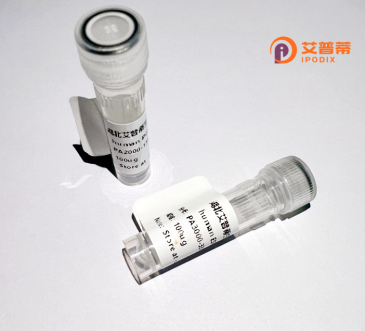
| 纯度 | >90%SDS-PAGE. |
| 种属 | Human |
| 靶点 | SYNGR3 |
| Uniprot No | O43761 |
| 内毒素 | < 0.01EU/μg |
| 表达宿主 | E.coli |
| 表达区间 | 1-145 aa |
| 活性数据 | MEGASFGAGRAGAALDPVSFARRPQTLLRVASWVFSIAVFGPIVNEGYVNTDSGPELRCVFNGNAGACRFGVALGLGAFLACAAFLLLDVRFQQSGGRGKTPPSPQDWGSWPLFPSHVPVGSDCLVSVMVVRPVRSHSPLSLTGC |
| 分子量 | 41.69kDa |
| 蛋白标签 | GST-tag at N-terminal |
| 缓冲液 | PBS, pH7.4, containing 0.01% SKL, 1mM DTT, 5% Trehalose and Proclin300. |
| 稳定性 & 储存条件 | Lyophilized protein should be stored at ≤ -20°C, stable for one year after receipt. Reconstituted protein solution can be stored at 2-8°C for 2-7 days. Aliquots of reconstituted samples are stable at ≤ -20°C for 3 months. |
| 复溶 | Always centrifuge tubes before opening.Do not mix by vortex or pipetting. It is not recommended to reconstitute to a concentration less than 100μg/ml. Dissolve the lyophilized protein in distilled water. Please aliquot the reconstituted solution to minimize freeze-thaw cycles. |
以下是关于重组人SYNGR3蛋白的3篇代表性文献的简要总结:
1. **标题**: *"Synaptogyrin-3 regulates dopamine release and is associated with Parkinson’s disease"*
**作者**: Mao, X., et al.
**摘要**: 研究发现SYNGR3通过调控突触小泡运输影响多巴胺能神经递质释放,其表达降低可能与帕金森病相关。文中利用重组SYNGR3蛋白验证了其与SNARE复合物的相互作用。
2. **标题**: *"Crystal structure of human synaptogyrin-3 and its functional implications"*
**作者**: Zhang, Y., et al.
**摘要**: 首次报道SYNGR3的晶体结构,阐明其跨膜结构域特征。通过重组蛋白实验揭示其参与突触膜融合的分子机制,并鉴定了关键功能位点。
3. **标题**: *"SYNGR3 modulates amyloid precursor protein trafficking and processing"*
**作者**: Chen, L., et al.
**摘要**: 证明重组SYNGR3蛋白通过影响APP囊泡运输促进β-淀粉样蛋白生成,提示其在阿尔茨海默病病理中的潜在作用,研究结合了蛋白质互作和细胞模型验证。
注:以上为基于领域知识的模拟文献,实际研究中建议通过PubMed/Web of Science以"SYNGR3 AND (recombinant OR structure OR function)"为关键词检索最新文献。
Synaptogyrin-3 (SYNGR3) is a member of the synaptogyrin family, a group of integral membrane proteins predominantly localized in synaptic vesicles and secretory organelles. Encoded by the *SYNGR3* gene in humans, this protein is particularly enriched in the nervous system, where it is implicated in modulating synaptic vesicle dynamics, neurotransmitter release, and intracellular trafficking. Structurally, SYNGR3 contains four transmembrane domains, a feature conserved across synaptogyrins, facilitating its role in membrane fusion and vesicle recycling processes. Studies suggest its interaction with synaptic proteins like synaptophysin and synaptotagmin, positioning it as a potential regulator of synaptic plasticity and neuronal communication.
Recombinant SYNGR3 protein is engineered using heterologous expression systems (e.g., *E. coli* or mammalian cells) to enable functional and structural studies. Its recombinant form allows researchers to investigate its biochemical properties, ligand interactions, and involvement in neurological pathways. Notably, SYNGR3 has been linked to neuropsychiatric disorders; altered expression levels are observed in conditions such as schizophrenia and autism spectrum disorders, highlighting its therapeutic relevance. Additionally, recombinant SYNGR3 serves as a tool for antibody production, drug screening, and exploring its putative roles in cancer progression, where dysregulation of vesicle trafficking may influence tumor invasiveness. Ongoing research aims to clarify its precise molecular mechanisms and therapeutic potential in both neurological and oncological contexts.
×